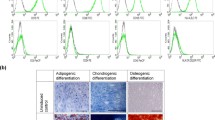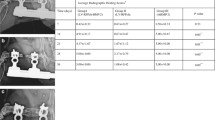Abstract
Bone marrow stem cells (BMSCs) are pluripotent cells that have been used to facilitate bone repair because of their capability of differentiating into osteoblasts. However, it is well known that the number of BMSCs with osteogenic potential decreases in patients with old age, osteoporosis, and metabolic diseases. In such conditions, xenogenic BMSCs may provide an alternative to autologous BMSCs. In the current study, we investigated the potential of transplanted xenogenic BMSCs to survive and generate new bone formation in the posterolateral lumbar spine of non-immunosuppressed rabbits. The BMSCs were obtained from bilateral femurs of four male rats, cultured and expanded in medium with osteoinduction supplement. The BMSCs (1,000,000 cells) of male rats loaded onto 5 cc compression resistant matrix (CRM; Medtronic Sofamor Danek, USA) were implanted bilaterally onto the L4-5 intertransverse processes of 16 female rabbits (xenogenic BMSCs + CRM group). The 16 female rabbits that received 5 cc CRM alone were used as controls (CRM alone group). To exclude the possibility of migration of BMSCs from the transverse processes of the recipient rabbits, we did not decorticate the transverse processes. No rabbits received any immunosuppressive medications during the experiment. Four rabbits each in both of the experimental and control groups were killed at 1, 2, 4, and 6 months postimplantation, and the lumbar spine underwent radiological and histological analyses for evaluation of new bone formation. The polymerase chain reaction (PCR) for Sry gene (Y-chromosome-specific marker) was used to evaluate the survival of transplanted xenogenic BMSCs. The expression of Sry gene was clearly identified in the lumbar spines of all the 16 rabbits in the xenogenic BMSCs + CRM group at 1–6 months postimplantation. Serial plain radiographs showed gradual resorption of CRM; however, it was difficult to clearly identify the presence of new bone formation due to the radiopacity of the remaining CRM. Histologically, mature lamellar and woven bone with osteoblasts and osteocytes were identified in all eight rabbits in the xenogenic BMSCs + CRM group at 4 and 6 months postimplantation, but in none of the eight rabbits at 1 and 2 months postimplantation. None of CRM alone group showed new bone formation at 1–6 months postimplantation. Mild-to-moderate infiltration of inflammatory cells was identified around the CRM carriers in both the groups. No post-operative wound infection was found in either group. Our results indicate that xenogenic BMSCs loaded onto CRM survive and generate new bone formation when placed into the posterolateral lumbar spine of rabbits without immunosuppression. To determine if a solid fusion can be achieved with such techniques, further studies are needed to investigate the appropriate dose of xenogenic BMSCs, amounts of CRM, and the requisite incubation time.




Similar content being viewed by others
References
Akamaru T, Duh D, Boden SD, Kim HS, Minamide A, Louis-Ugbo J (2003) Simple carrier matrix modification can enhance delivery of recombinant huma bone morphogenic protein-2 for posterolateral spine fusion. Spine 28:429–434. doi:10.1097/00007632-200303010-00004
Arinzeh TL, Peter SJ, Archambault MP, van de Bos C, Gordon S, Kraus K et al (2003) Allogenic mesenchymal stem cells regenerate bone in a critical-sized canine segmental defect. J Bone Joint Surg Am 85:1927–1935
Bartholomew A, Sturgeon C, Siatkas M, Ferrer K, McIntosh K, Patil S et al (2002) Mesenchymal stem cells suppress lymphocu\yte proliferation in vitro and prolong skin graft survival in vivo. Exp Hematol 30:42–48. doi:10.1016/S0301-472X(01)00769-X
Beresford JN (1989) Osteogenic stem cells and the stromal system of bone and marrow. Clin Orthop Relat Res 240:270–280
Bruder SP, Jaiswal N, Haynesworth SE (1997) Growth kinetics, self-renewal, and the osteogenic potential of purified human mesenchymal stem cells during extensive subcultivation and following cryopreservation. J Cell Biochem 64:278–294. doi:10.1002/(SICI)1097-4644(199702)64:2<278::AID-JCB11>3.0.CO;2-F
Bruder SP, Kraus KH, Goldberg VM, Kadiyala S (1998) The effect of implants loaded with autologous mesenchymal stem cells on the healing of canine segmental bone defects. J Bone Joint Surg Am 80:985–996
Ettinger M (2003) Aging bone and osteoporosis. Strategies for preventing fractures in the elderly. Arch Intern Med 163:2237–2246. doi:10.1001/archinte.163.18.2237
Friedenstein AJ, Chailakhyan RK, Gerasimov UV (1987) Bone marrow osteogenic stem cells: in vitro cultivation and transplantation in diffusion chambers. Cell Tissue Kinet 20:263–272
Grinnemo KH, Mansson A, Dellgren G, Klinberg D, Wardell E, Drvota V et al (2004) Xenoreativity and engraftment of human mesenchymal stem cells transplantation into infracted rat myocardium. J Thorac Cardiovasc Surg 27:1293–1300. doi:10.1016/j.jtcvs.2003.07.037
Heersche JN, Bellows CG, Ishida Y (1998) The decerase in bone mass associated with aging and menopause. J Prosthet Dent 79:14–16. doi:10.1016/S0022-3913(98)70187-8
Heise U, Osborn JF, Duwe F (1990) Hydroxyapatite ceramic as a bone substitute. Int Orthop 14:329–338. doi:10.1007/BF00178768
Hirasawa A, Tsujimoto G, Okuyama S, Li XK, Iwaya M, Masaki Y et al (1995) Polymerase chain reaction of the rat sex-determining region of the Y-chromosome and its application to estimate a state of sensitization to minor histocompatability antigen H-Y. Transplant Proc 27:1598–1600
Jaiswal N, Haynesworth SE, Caplan AI, Bruder SP (1997) Osteogenic differentiation of purified, culture-expanded human mesenchymal stem cells in vitro. J Cell Biochem 64:295–312. doi:10.1002/(SICI)1097-4644(199702)64:2<295::AID-JCB12>3.0.CO;2-I
Le Blanc K, Tammik L, Sundberg B, Haynesworth SE, Ringdén O (2003) Mesenchymal stem cells inhibit and stimulate mixed lymphocyte cultures and mitogenic responses independently of the major histocompatibility complex. Scand J Immunol 57:11–20. doi:10.1046/j.1365-3083.2003.01176.x
Le Heuc JC, Lesprit E, Delavigne C, Clement D, Chauveaux D, Le Rebeller A (1997) Tri-calcium pjosphate ceramics and allografts as bone substitutes for spinal fusion in idiopathic scoliosis: comparative clinical results at four years. Acta Orthop Belg 63:202–211
Lennon DP, Haynesworth SE, Bruder SP, Jaiswal NJ, Caplan AI (1996) Human and animal mesenchymal progenitor cells from bone marrow: identification of serum for optimal selection and proliferation. In Vitro Cell Dev Biol 32:602–611. doi:10.1007/BF02724045
Lieberman JR, Daluiski A, Stevenson S, Wu L, McAlister P, Lee YP et al (1999) The effect of regional gene therapy with bone morphogenic protein-2-producing bone-marrow cells on the repair of segmental femoral defects in rats. J Bone Joint Surg Am 81:905–917
Lou J, Xu F, Merkle K, Manske P (1999) Gene therapy: adenovirus-mediated human bone morphogenic protein-2 gene transfer induces mesenchymal progenitor cell proliferation and differentiation in vitro and bone formation in vivo. J Orthop Res 17:43–50. doi:10.1002/jor.1100170108
MacDonald DJ, Luo J, Saito T, Duong M, Bernier PL, Chiu RC et al (2005) Persistence of marrow stromal cells implanted into acutely infarcted myocardium: observations in a xenotransplant model. J Thorac Cardiovasc Surg 130:1114–1121. doi:10.1016/j.jtcvs.2005.04.033
Muramatsu K, Valenzuela RG, Bishop AT (2003) Detection of chimerism following vascularized bone allotransplantation by polymerase chain reaction using a Y-chromosome specific primer. J Orthop Res 21:1056–1062. doi:10.1016/S0736-0266(03)00108-6
Passuti N, Daculsi G, Rogez JM, Martin S, Bainvel JV (1989) Macroporous calcium phosphate ceramic performance in human spine fusion. Clin Orthop Relat Res 248:169–176
Patri S, Dascalescu C, Chomel JC, Sadoun A, Lacotte L, Tanzer J et al (1996) Monitoring and prognosctic evaluation of sex-mismatched bone marrow transplantation by competitive PCR on Y-chromosome sequences. Bone Marrow Transplant 17:625–632
Pittenger MF, Mackay AM, Beck SC, Jaiswal RK, Douglas R, Mosca JD et al (1997) Multilineage potential of adult human mesenchymal stem cells. Science 284:143–147. doi:10.1126/science.284.5411.143
Ringe J, Kaps C, Schmitt B, Büscher K, Bartel J, Smolian H et al (2002) Porcine mesenchymal stem cells. Induction of distinct mesenchymal cell lineages. Cell Tissue Res 307:321–327. doi:10.1007/s00441-002-0525-z
Rasmusson I (2006) Immune modulation by mesenchymal stem cells. Exp Cell Res 312:2169–2179. doi:10.1016/j.yexcr.2006.03.019
Riew KD, Wright NM, Cheng S-L, Avioli LV, Lou J (1998) Induction of bone formation using a recombinant adenoviral vector carrying the human BMP-2 gene in a rabbit spinal fusion model. Calcif Tissue Int 63:357–360. doi:10.1007/s002239900540
Russel JL, Block JE (2000) Surgical harvesting of bone graft from the ilium: point of view. Med Hypotheses 55:474–479. doi:10.1054/mehy.2000.1095
Saito T, Kuang JQ, Bittira B, Al-Khaldi A, Chiu RC (2002) Xenotransplant cardiac chimera: immune tolerance of adult stem cells. Ann Thorac Surg 74:19–24. doi:10.1016/S0003-4975(02)03591-9
Tashiro H, Fukuda Y, Hoshino S, Furukawa M, Shintaku S, Dohi K (1995) Monitoring for engraftment following rat orthotopic liver transplantation by in vitro amplication of Y-chromosome gene using polymerase chain reaction. Cell Transplant 4:61–63. doi:10.1016/0963-6897(94)00060-W
Wang Y, Chen X, Armstrong MA, Li G (2007) Survival of bone marrow-derived mesenchymal stem cells in a Xenotransplantation model. J Orthop Res 25:926–932. doi:10.1002/jor.20385
Wang L, Lu XF, Lu YR, Liu J, Gao K, Zeng YZ et al (2006) Immunogenicity and immune modulation of osteogenic differentiated mesenchymal stem cells from Banna Minipig Inbred Line. Transplant Proc 38:2267–2269. doi:10.1016/j.transproceed.2006.06.048
Wilborn F, Schmidt CA, Siegert W (1993) Demonstration of chimerism after allogenic bone marrow transplantation by polymerase chain reaction of Y-chromosome-specific nucleotide sequences—characterization of a technical approach. Leukemia 7:140–143
Acknowledgment
This work was supported by year 2006 research fundings of Catholic Institute of Cell Therapy, The Catholic University of Korea School of Medicine.
Author information
Authors and Affiliations
Corresponding author
Rights and permissions
About this article
Cite this article
Kim, HJ., Park, JB., Lee, J.K. et al. Transplanted xenogenic bone marrow stem cells survive and generate new bone formation in the posterolateral lumbar spine of non-immunosuppressed rabbits. Eur Spine J 17, 1515–1521 (2008). https://doi.org/10.1007/s00586-008-0784-9
Received:
Revised:
Accepted:
Published:
Issue Date:
DOI: https://doi.org/10.1007/s00586-008-0784-9




